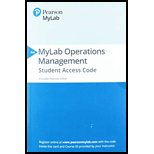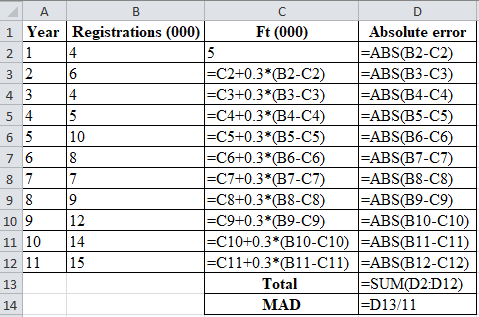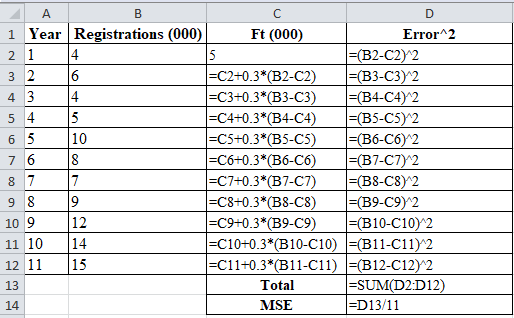
Use exponential smoothing with a smoothing constant of 0.3 to
a) What is the MAD?
b) What is the MSE?
a)
To determine: Forecast the registrations at the seminar using exponential smoothing and hence compute MAD.
Introduction: Forecasting is used to predict future changes or demand patterns. It involves different approaches and varies with different time periods. Exponential Smoothing and Naïve forecasting methods are two of the time series methods of forecasting which use past data to forecast the future.
Answer to Problem 11P
Using exponential smoothing, the registrations at the seminar are forecasted and the computed MAD is 2.44.
Explanation of Solution
Given information:
| Year | Registrations (000) |
| 1 | 4 |
| 2 | 6 |
| 3 | 4 |
| 4 | 5 |
| 5 | 10 |
| 6 | 8 |
| 7 | 7 |
| 8 | 9 |
| 9 | 12 |
| 10 | 14 |
| 11 | 15 |
Formula to calculate the forecasted demand
Where,
Calculation to forecast demand using exponential smoothing:
| Year | Registrations (000) | Ft (000) |
| 1 | 4 | 5 |
| 2 | 6 | 4.700 |
| 3 | 4 | 5.090 |
| 4 | 5 | 4.763 |
| 5 | 10 | 4.834 |
| 6 | 8 | 6.384 |
| 7 | 7 | 6.869 |
| 8 | 9 | 6.908 |
| 9 | 12 | 7.536 |
| 10 | 14 | 8.875 |
| 11 | 15 | 10.412 |
Table 1
Excel calculation:

Calculation of forecast for year 2:
To calculate the forecast for year 2, substitute the value of the forecast of year 1, smoothing constant, and difference of actual and forecasted demand in the above formula. The result of forecast for year 2 is 4.70
Calculation of forecast for year 3:
To calculate the forecast for year 3, substitute the value of the forecast of year 1, smoothing constant, and difference of actual and forecasted demand in the above formula. The result of forecast for year 3 is 5.09
Calculation of forecast for year 4:
To calculate the forecast for year 4, substitute the value of the forecast of year 3, smoothing constant, and difference of actual and forecasted demand in the above formula. The result of forecast for year 3 is 4.763
Calculation of forecast for year 5:
To calculate the forecast for year 5, substitute the value of the forecast of year 4, smoothing constant, and difference of actual and forecasted demand in the above formula. The result of forecast for year 5 is 4.834
Calculation of forecast for year 6:
To calculate the forecast for year 6, substitute the value of the forecast of year 5, smoothing constant, and difference of actual and forecasted demand in the above formula. The result of forecast for year 5 is 6.384
Calculation of forecast for year 7:
To calculate the forecast for year 7, substitute the value of the forecast of year 6, smoothing constant, and difference of actual and forecasted demand in the above formula. The result of forecast for year 7 is 6.869
Calculation of forecast for year 8:
To calculate the forecast for year 8, substitute the value of the forecast of year 7, smoothing constant, and difference of actual and forecasted demand in the above formula. The result of forecast for year 8 is 6.908
Calculation of forecast for year 9:
To calculate the forecast for year 9, substitute the value of the forecast of year 8, smoothing constant, and difference of actual and forecasted demand in the above formula. The result of forecast for year 8 is 7.536
Calculation of forecast for year 10:
To calculate the forecast for year 10, substitute the value of the forecast of year 9, smoothing constant, and difference of actual and forecasted demand in the above formula. The result of forecast for year 9 is 8.875
Calculation of forecast for year 11:
To calculate the forecast for year 11, substitute the value of the forecast of year 10, smoothing constant, and difference of actual and forecasted demand in the above formula. The result of forecast for year 10 is 10.412
The forecasted value of registrations using exponential smoothing is provided in table 1
Calculation of MAD using exponential smoothing
Formula to calculate MAD
Table 1 provides the adequate forecasted data to compute MAD.
| Year | Registrations (000) | Ft (000) | Absolute error |
| 1 | 4 | 5.000 | 1 |
| 2 | 6 | 4.700 | 1.30 |
| 3 | 4 | 5.090 | 1.09 |
| 4 | 5 | 4.763 | 0.24 |
| 5 | 10 | 4.834 | 5.17 |
| 6 | 8 | 6.384 | 1.62 |
| 7 | 7 | 6.869 | 0.13 |
| 8 | 9 | 6.908 | 2.09 |
| 9 | 12 | 7.536 | 4.46 |
| 10 | 14 | 8.875 | 5.13 |
| 11 | 15 | 10.412 | 4.59 |
| Total | 26.81 | ||
| MAD | 2.44 |
Table 2
Excel calculation:

Mean Absolute Deviation:
Mean Absolute Deviation is obtained by dividing the summation of absolute values by the number of years. Absolute error is obtained by taking modulus for the difference between actual and forecasted values.
Calculation of absolute error for year 1
The absolute error for year 1 is the modulus of the difference between 4 and 5, which corresponds to 1. Therefore absolute error for year 1 is 1.
Calculation of absolute error for year 2
The absolute error for year 2 is the modulus of the difference between 6 and 4.7, which corresponds to 1.30. Therefore absolute error for year 2 is 1.30
Calculation of absolute error for year 3
The absolute error for year 3 is the modulus of the difference between 4 and 5.09, which corresponds to 1.09. Therefore absolute error for year 1.09
Calculation of absolute error for year 4
The absolute error for year 4 is the modulus of the difference between 5 and 4.763, which corresponds to 0.24. Therefore absolute error for year 4 is 0.24
Calculation of absolute error for year 5
The absolute error for year 5 is the modulus of the difference between 10 and 4.834, which corresponds to 5.17. Therefore absolute error for year 5 is 5.17
Calculation of absolute error for year 6
The absolute error for year 6 is the modulus of the difference between 8 and 6.384, which corresponds to 1.62. Therefore absolute error for year is 1.62
Calculation of absolute error for year 7
The absolute error for year 7 is the modulus of the difference between 7 and 6.869, which corresponds to 0.13. Therefore absolute error for year is 0.13
Calculation of absolute error for year 8
The absolute error for year 8 is the modulus of the difference between 9 and 6.908, which corresponds to 2.09. Therefore absolute error for year is 2.09
Calculation of absolute error for year 9
The absolute error for year 9 is the modulus of the difference between 12 and 7.536, which corresponds to 4.46. Therefore absolute error for year is 4.46
Calculation of absolute error for year 10
The absolute error for year 10 is the modulus of the difference between14 and 8.875, which corresponds to 5.13. Therefore absolute error for year is 5.13
Calculation of absolute error for year 11
The absolute error for year 11 is the modulus of the difference between 15 and 10.412, which corresponds to 4.59. Therefore absolute error for year is 4.59
Calculation of MAD using exponential smoothing
Upon substitution of summation, the value of absolute error for 11 years, that is, 26.81 is divided by number of years, that is, 11 yields MAD of 2.44
Hence, using exponential smoothing, the registrations at the seminar are forecasted and the computed MAD is 2.44
b)
To determine: Forecast the registrations at the seminar using exponential smoothing and hence compute MSE.
Answer to Problem 11P
Using exponential smoothing, the registrations at the seminar are forecasted and the computed MSE is 9.53
Explanation of Solution
Given information:
| Year | Registrations (000) |
| 1 | 4 |
| 2 | 6 |
| 3 | 4 |
| 4 | 5 |
| 5 | 10 |
| 6 | 8 |
| 7 | 7 |
| 8 | 9 |
| 9 | 12 |
| 10 | 14 |
| 11 | 15 |
Formula to calculate MSE
Table 1 provides the required forecasted data which in turn is used to compute MSE.
| Year | Registrations (000) | Ft (000) | Error2 |
| 1 | 4 | 5 | 1 |
| 2 | 6 | 4.700 | 1.69 |
| 3 | 4 | 5.090 | 1.19 |
| 4 | 5 | 4.763 | 0.06 |
| 5 | 10 | 4.834 | 26.69 |
| 6 | 8 | 6.384 | 2.61 |
| 7 | 7 | 6.869 | 0.02 |
| 8 | 9 | 6.908 | 4.38 |
| 9 | 12 | 7.536 | 19.93 |
| 10 | 14 | 8.875 | 26.27 |
| 11 | 15 | 10.412 | 21.05 |
| Total | 104.87 | ||
| MSE | 9.53 |
Table 3
Excel calculation:

Error is the difference between actual and forecasted values. Table 2 provides the value of Error for the forecasted and given values.
Calculation of MSE
MSE is obtained by dividing the summation of the square of error (refer to Table (3)) with the n number of periods, that is, 11.
Hence, using exponential smoothing, the registrations at the seminar are forecasted and the computed MSE is 9.53.
Want to see more full solutions like this?
Chapter 4 Solutions
Pearson eText Principles of Operations Management: Sustainability and Supply Chain Management -- Instant Access (Pearson+)
- The oasis outpost of Abu Ilan, in the heart of the Negev desert, has a population of 20 Bedouin tribesmen and 20 Farima tribesmen. El Kamin, a nearby oasis, has a population of 32 Bedouins and 8 Farima. A lost Israeli soldier, accidentally separated from his army unit, is wandering through the desert and arrives at the edge of one of the oases. The soldier has no idea which oasis he has found, but the first person he spots at a distance is a Bedouin. 1. What is the probability that he wandered into Abu Ilan? 2. What is the probability that he is in El Kamin?arrow_forward2-22 The lost Israeli soldier mentioned in Problem 2-21 decides to rest for a few minutes before entering the desert oasis he has just found. Closing his eyes, he dozes off for 15 minutes, wakes, and walks toward the center of the oasis. The first person he spots this time he again recognizes as a Bedouin. What is the posterior probability that he is in El Kamin?*Note* 2-21 The oasis outpost of Abu Ilan, in the heart of the Negev desert, has a population of 20 Bedouin tribesmen and 20 Farima tribesmen. El Kamin, a nearby oasis, has a population of 32 Bedouins and 8 Farima. A lost Israeli soldier, accidentally separated from his army unit, is wandering through the desert and arrives at the edge of one of the oases. The soldier has no idea which oasis he has found, but the first person he spots at a distance is a Bedouin. What is the probability that he has wandered into Abu Ilan? What is the probability that he is in El Kamin?arrow_forwardHello, please make an excel of this. Show all the cells thanks. some replied with a paper answer thank you I just cant understand the way the did it. Can someone show me all screenshots o fthis problem solved and in excel? i need to solver too for the constraints. I seen multiple times across other platforms that one of the chairs optimal solutions is 0 but they both have to be higher than 1 The Heinrich Company manufactures two types of plastic hangerracks (Foldaways and Straightaways) especially suited for mountingnear clothes dryers. Because permanent press clothing must be hungon hangers immediately after removal from the dryer, these items havebeen especially popular. However, there is some concern that thePreppie movement (popularized by its own handbook) will extinguishpolyester clothing; Heinrich is terribly interested in doing the best withthe resources it has while its products are still in demand. The firsttype of hanger rack, the Foldaway, requires 10 ounces of…arrow_forward
- Review the Profit Ratio by Product chart again. What information is uncovered when the data is less aggregated than the data in Profit Ratio by Category chart?arrow_forwardWhat is the correlation between Measure A and Measure B in this example?arrow_forward1) View the video ON Unveils ‘Lightspray’ Technology (4.55 mins, Ctrl+Click in the link), and The Secret of Lightspray (8.27 mins, Ctrl+Click in the link), answer the following questions: https://www.youtube.com/watch?v=wjmeaC-wlZs a) What is new about the design of ON’s shoes? b) How will ON’s new manufacturing technique affect location planning for footwear firms? c) How does ON focus on it sustainability strategy? Note: As a rough guideline, please try to keep the written submission to one or two paragraphs for each of the questions. 2) Unimed Hospital currently processes patient admissions through three admitting clerks who are set up to work in series, with respective reliabilities of 0.96, 0.95, and 0.90 (see figure below). a) Find the reliability of the current admission process. Due to rising patient complaints, the hospital administrator, Chimeg Ganbaatar, has decided to improve the reliability of the admission process by providing backup clerks for two of the…arrow_forward
- + < Question 21 of 39 What is the correct common name for the compound shown here? 2-methoxyprop ane | 3-1-2- n-tert- iso sec- eth prop meth methoxy propoxy ethoxy yl acid ether ester ane Reset ☑ Submitarrow_forward(25 Marks) Discuss how you would "reset the store estate" to remain competitive and relevant in the market?arrow_forwardHello, please make an excel of this. Show all the cells thanks The Heinrich Company manufactures two types of plastic hangerracks (Foldaways and Straightaways) especially suited for mountingnear clothes dryers. Because permanent press clothing must be hungon hangers immediately after removal from the dryer, these items havebeen especially popular. However, there is some concern that thePreppie movement (popularized by its own handbook) will extinguishpolyester clothing; Heinrich is terribly interested in doing the best withthe resources it has while its products are still in demand. The firsttype of hanger rack, the Foldaway, requires 10 ounces of plasticmaterial and 0.3 hours of labor. Plastic costs Heinrich 10 cents anounce; labor costs Heinrich $20 per hour. The second type of hangerrack, the Straightaway, requires 15 ounces of plastic and 0.175 hoursof labor. The prices of these resources are the same as those for theFoldaway. Under current market conditions, Heinrich can sell…arrow_forward
- FORMATIVE ASSESSMENT 1 Read the article below and answer ALL the questions Pick n Pay reveals strategy to restore its business 27 May 2024 [100 MARKS] Following a disappointing full year performance for FY24, Pick n Pay CEO Sean Summers has unveiled the new board- approved six-point strategy to restore the Group's core Pick n Pay supermarket business to profitability. PHASED APPROACH IMPLEMENTATION Leverage strength of partnerships Leadership and people 2 Reset the store estate 3 Improve offer to drive sales 4 Optimise operating model Leverage strength of partnerships Recapitalisation Pick n Pay Prod FY26 FY27 Before Tax break-even FY25 Halve Group H2 FY24 H1 FY25 H2 FY25 H1 FY26 H2 FY26 HI FY27 H2 FY27 KEY IMPACT AND/OR TARGETED OUTCOMES Appointing the right people, in the optimal roles, to Directly and indirectly impact revenue growth drivers and 1 drive sales and realise margin improvement 5 enhances gross and operating margins 2 Expected notable associated savings/loss avoidance…arrow_forwardWith an enormous amount of data stored in databases and data warehouses, it is increasinglyimportant to develop powerful tools for analysis of such data and mining interestingknowledge from it. Data mining is a process of inferring knowledge from such huge data. Themain problem related to the retrieval of information from the World Wide Web is theenormous number of unstructured documents and resources, i.e., the difficulty of locating andtracking appropriate sources. Your company is considering investing in a Human Resource Information System (HRIS).Briefly explain the strategies for justifying HRIS investments.arrow_forwardYour company is considering investing in a Human Resource Information System (HRIS).Briefly explain the strategies for justifying HRIS investments.arrow_forward
- MarketingMarketingISBN:9780357033791Author:Pride, William MPublisher:South Western Educational Publishing
 Contemporary MarketingMarketingISBN:9780357033777Author:Louis E. Boone, David L. KurtzPublisher:Cengage Learning
Contemporary MarketingMarketingISBN:9780357033777Author:Louis E. Boone, David L. KurtzPublisher:Cengage Learning Purchasing and Supply Chain ManagementOperations ManagementISBN:9781285869681Author:Robert M. Monczka, Robert B. Handfield, Larry C. Giunipero, James L. PattersonPublisher:Cengage Learning
Purchasing and Supply Chain ManagementOperations ManagementISBN:9781285869681Author:Robert M. Monczka, Robert B. Handfield, Larry C. Giunipero, James L. PattersonPublisher:Cengage Learning  Practical Management ScienceOperations ManagementISBN:9781337406659Author:WINSTON, Wayne L.Publisher:Cengage,
Practical Management ScienceOperations ManagementISBN:9781337406659Author:WINSTON, Wayne L.Publisher:Cengage,





